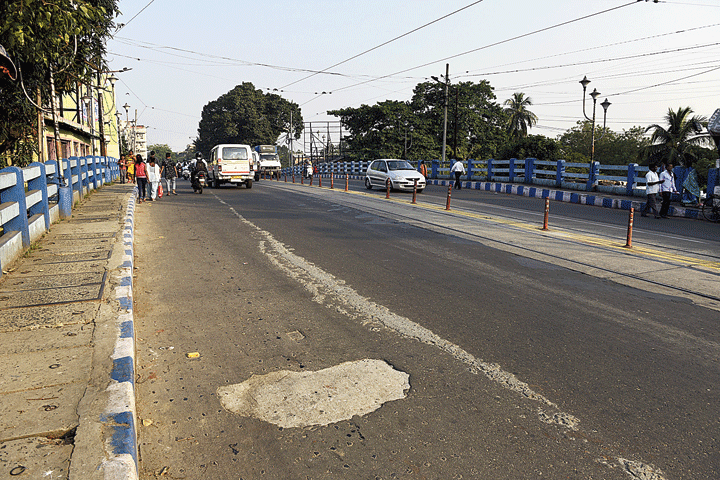A bridge that connects Alipore with Kalighat over Tolly’s Nullah has come under the scanner for poor health. Engineers, who conducted a health study of Kalighat bridge, have concluded that replacing the structure with a new one would be ideal.
The engineers have said that the bridge was too weak to bear heavy load and some of its steel reinforcements had undergone heavy corrosion, prompting them to recommend its replacement.
They have said that for now small vehicles can ply on it but only after adequate repairs of the 45-year-old structure.
“Kalighat is the only bridge out of the nine that have been scanned where we have asked the consulting agency that conducted the health study to suggest the cost of building a new one,” said a senior engineer of the Calcutta Metropolitan Development Authority (CMDA).
“The agency has been asked to come up with its cost-estimation report by November,” he said.
Spread over 1.5km, the Kalighat bridge connects parts of Chetla, Gopalnagar, Alipore and Kidderpore to Kalighat and parts of south Calcutta.
In July, a load-bearing test of the structure was conducted as a part of the urban development department’s initiative to conduct health study of several flyovers and bridges in the aftermath of the Majerhat bridge collapse in September last year.
A Mumbai-headquartered company had carried out the test, which included mounting fully loaded lorries in the middle of the bridge for two days and then calculating “deflections” in the components.
Besides the load tests, the agency had also studied the quality of the concrete and the steel with the help of ultra-sound waves and calculated the PH value of the subsoil.
The report was recently submitted to a committee of bridge engineers. The report has revealed that signs of stress on the Kalighat bridge were visible.
Sources said the report suggested that some of the deck slabs of the bridge needed immediate repair. The steel embedded in the deck slabs and several pillars of the bridge had undergone heavy corrosion.
The report even mentions that the “acidic water” of Tolly’s Nullah had contributed to the corrosion of steel. Water has seeped into the deck slabs resulting in plants growing in some parts.
Even as engineers continue to calculate the cost of building a new bridge, the urban development department has sought immediate installation of height bars to prevent heavy vehicles from plying on the structure. Sources said Calcutta police had already banned heavy vehicles on the bridge.
“The height bars would be around 3.5 metres high. The exact spots where they would be installed have been identified,” said a senior officer of Bhowanipore traffic guard, which will execute the project. “Within the next few weeks the bars should come up,” he said.
Engineers said installing height bars was one of the most effective ways of restricting heavy vehicles that tend to defy bans and evade the police. After Chingrighata and Ultadanga flyover, the police have installed height barriers at Zeerut bridge near Alipore zoo after engineers said the existing steel structure was not ready to bear heavy load. Similar height barriers have been on installed at either end of Tallah bridge to prevent heavy vehicles from taking the structure.










